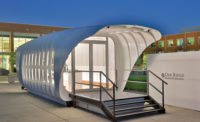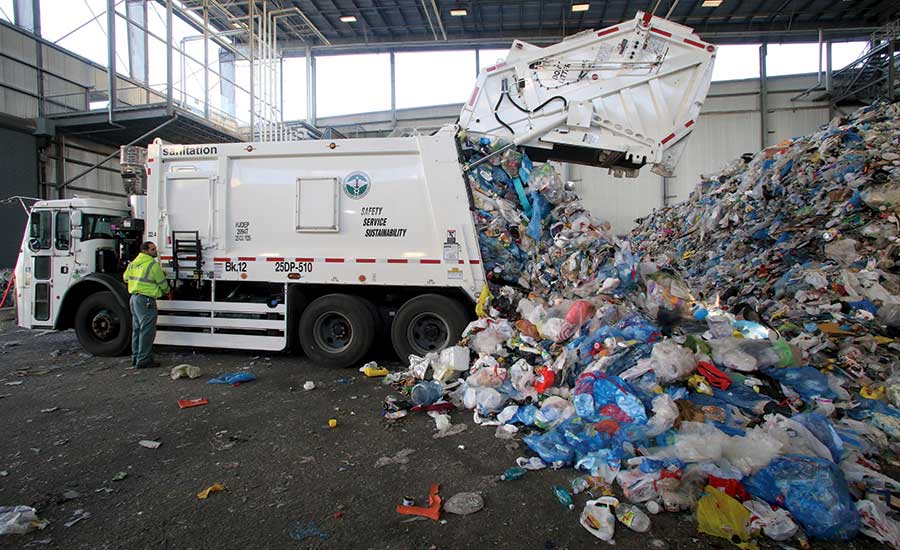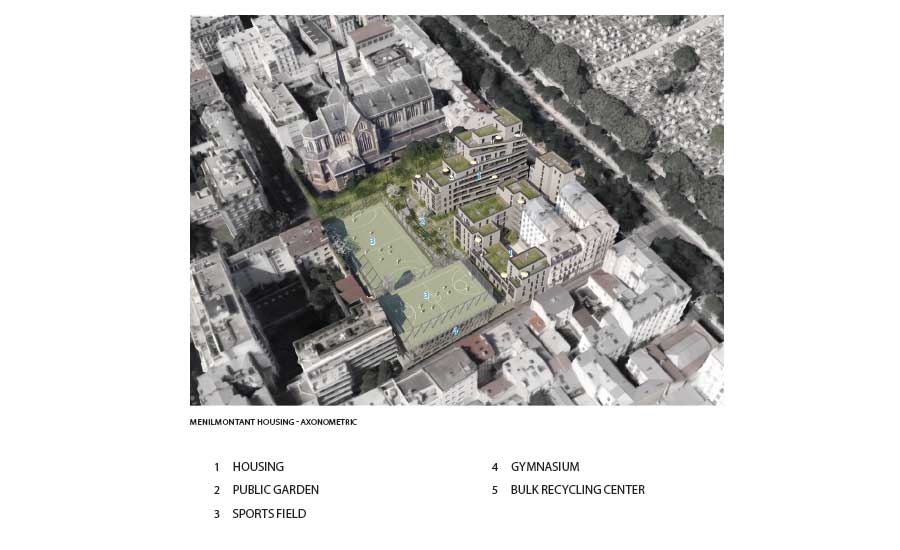Continuing Education: Zero Waste

Recyclables from New York households, including plastic, metal, and glass, arrive at a facility in Brooklyn for sorting.
Photo © Michael Anton, courtesy DSNY

One way New York could meet its 2030 goals is by cutting the current amount of trash (above) produced by 80 percent, reducing the quantity of recyclables generated by 50 percent, and ramping up diversion of recyclables to 90 percent.
Image courtesy The Center for Architecture

One way New York could meet its 2030 goals (above) is by cutting the current amount of trash produced by 80 percent, reducing the quantity of recyclables generated by 50 percent, and ramping up diversion of recyclables to 90 percent.
Image courtesy The Center for Architecture

As part of San Francisco International Airport’s zero-waste by 2021 initiative, Gensler designed new receptacles and graphics to be used throughout the facility to help increase sorting accuracy and diversion.
Image courtesy Gensler

MENILMONTANT HOUSING – SECTION
Paris plans to have a bulk waste facility, or espace tri, in every arrondissement by 2020. Vincente Lavergne Architecture has included one below a sports field in an 85-unit social-housing complex it has designed for the 11th arrondissement.
Image courtesy Vincent Lavergne Architecture Urbanisme

Paris plans to have a bulk waste facility, or espace tri, in every arrondissement by 2020. Vincente Lavergne Architecture has included one below a sports field in an 85-unit social-housing complex it has designed for the 11th arrondissement.
Image courtesy Vincent Lavergne Architecture Urbanisme

Perkins+Will’s Chou Hall at the University of California, Berkeley, a classroom facility for the business school, is on track to be the first academic building to earn LEED, WELL, and TRUE certifications.
Photo © Blake Marvin

Perkins+Will’s Chou Hall at the University of California, Berkeley, a classroom facility for the business school, is on track to be the first academic building to earn LEED, WELL, and TRUE certifications.
Photo © Blake Marvin








Architects—even those who don’t call themselves super-green—by now are obliged to design buildings that conserve energy and water. But do they expect to create structures that allow occupants to better manage and reduce the waste they produce? Not so much. Nevertheless, that is what a number of zero waste champions say is needed.
How can architects help? First, the background: every day, Americans create mountains of trash. We toss food scraps, garden clippings, dog-eared magazines, soiled takeout containers, threadbare clothing, and broken furniture. In 2015, the U.S. generated approximately 262 million tons of municipal solid waste, according to the most recent figures available from the Environmental Protection Agency. But, of that, only 91 million tons, or less than 35 percent, was recycled or composted. The majority was sent to landfills or incinerated.
As everyone knows, trash and recyclables clutter loading docks and obstruct basements. Garbage bags clog sidewalks and attract vermin, while the collection of this refuse exacerbates traffic and has an adverse impact on air quality. Municipalities and businesses spend huge sums to dispose of their waste, often shipping it to distant states or even internationally to landfills or recycling centers.
Less well known, perhaps, is the relationship between the disposal of waste and global warming. Since landfill gas is in large part methane—a greenhouse gas that is many times more potent than CO2—effective resource and waste management are needed to slash heat-trapping emissions. According to the Green Business Certification Inc. (GBCI), increasing the national recycling rate by just 8 percent and reducing the amount of waste we generate by only 5 percent could eliminate the equivalent of 20 million metric tons of carbon.
Many progressive cities, of course, do recognize better management of their refuse as a powerful climate-change mitigation tool and have adopted ambitious waste-reduction targets in their long-rage environmental plans. This summer, 23 cities signed on to an “advancing towards zero waste declaration,” sponsored by C40 Cities, a global environmental non-profit organization. The signatories, which included seven U.S. cities, pledged that by 2030 they would reduce the amount of waste generated by each inhabitant by 15 percent and cut the amount sent to landfills or incineration by half.
What does the term “zero waste” actually mean? The Zero Waste International Alliance defines it as “designing and managing products and processes to systematically avoid and eliminate the volume and toxicity of water and materials, conserve and recover all resources, and not burn or bury them.” In practice, however, absolute zero is a tough mark to attain, especially for industrial economies, and many international and U.S. organizations recognize a 90 percent diversion rate from incinerators, landfills, or the environment as zero waste.
New York is one city whose zero-waste goals call for reducing what it sends to landfills and incinerators by 90 percent by 2030 (compared with a 2005 baseline of 3.6 million tons). Now, however, only about 20 percent of the garbage the city produces each day is diverted, and just over half of the metal, glass, and plastic that inhabitants discard is collected for recycling. A meager four percent of food scraps and other organic waste is collected for composting, through a voluntary program. To have any hope of reaching its targets, the city will have to drastically reduce the amount of waste generated and dramatically ramp up recycling and composting rates.
Architecture and design can help remove some of the roadblocks in the way of achieving goals like those adopted by New York, according to zero-waste advocates. One way is through clearer messaging. “People don’t recycle, because it is confusing,” says Ushma Pandya Mehta, cofounder of Think Zero, a waste-reduction and diversion consultant. The rules are constantly changing, and they are different from place to place, she says. But facilities with good signage and well-placed receptacles—along with education—typically see strong participation, adds her Think Zero partner, Sarah Currie-Halpern.
That’s what San Francisco International Airport (SFO) is banking on. As part of its goal to reach zero waste by 2021, it examined all aspects of airport operations, including offices, maintenance shops, and terminals. Then it reached out to Gensler for help. Sustainability director David Briefel describes the firm’s role as one that was “graphics heavy” but also involved coordinating with SFO management and custodial staff and assisting with studies of waste-diversion rates and sorting accuracy at security screening points, food concourses, gates, and at back-of-house areas. The physical product of this exercise was new trash receptacles and signage intended to help airport users and employees better differentiate the various waste streams. The graphics and bins have so far been installed in Terminal 2, but will ultimately be implemented airport-wide.
Reducing waste and recovering more for recycling and reuse can also entail infrastructure-scale strategies, such as the installation of pneumatic tube systems. Powered by turbines that generate a vacuum, these whisk away trash at high speeds to a central terminal. The technology reduces the amount of space that individual buildings must devote to storage of waste and eliminates the need for piling trash bags at the curb. Best-suited for new, multibuilding complexes, the first systems were installed in Sweden in the 1960s and now exist all over the world.
Although they are still rare in the U.S., the apartment buildings on New York’s Roosevelt Island have a single-stream system that has been in continuous operation since 1975. It has been expanded several times and now serves 12,000 residents in 16 buildings. By the middle of the next decade, the city could have another complex relying on pneumatic waste collection. Plans for the primarily residential second phase of Hudson Yards—the megadevelopment rising over rail lines on Manhattan’s far West Side—include a pneumatic network with dedicated tubes for landfill items, recycling, and organics that would connect to seven buildings with a total of 4,000 apartments.
New developments can also provide resources that serve a much larger surrounding urban district. Clare Miflin, an architect and founder of ThinkWoven, a New York–based urban-ecology consulting firm, points to Ménilmontant, an 85-unit social-housing complex under construction in Paris’ 11th arrondissement. In addition to incorporating a community garden and neighborhood sports facilities, it will include a below-grade espace tri—a staffed facility that will accept items that Parisians are not permitted to dispose of at curbside, such as appliances, furniture, and household hazardous waste. As part of its long-range environmental plans, the city aims to establish such a bulk waste center in every arrondissement by 2020. Ménilmontant’s espace tri will be the first in a residential complex. According to Pierre Maurette, a partner at Vincent Lavergne Architecture Urbanisme, the integration of the facility with the other neighborhood amenities was one of the reasons his firm was selected for the project.
Tools are starting to emerge that can help architects and their clients better manage the waste stream. Last year, AIA New York and a host of collaborators, including the Rockefeller Foundation, published a set of Zero Waste Design Guidelines, a 270-page examination of commercial and residential building design, urban infrastructure, collection methods, and policy. Already the document is influencing design decisions. The guidelines helped persuade the project team for Sendero Verde—a 655-unit mixed-income housing project for the Harlem neighborhood—to include a second trash chute for recyclables, according to Lauren Zullo, director of environmental impact for developer Jonathan Rose Companies. The three-building complex, by Handel Architects, slated for completion in 2021, is targeting Passive House certification, but also has a goal of waste-stream optimization, she says.
The guidelines are focused on solutions for New York, its unique building typologies, and its dense urban condition, but organizations in other locales are taking notice. Groups in Seattle are among those interested in adapting the recommendations to their circumstances, according ThinkWoven’s Miflin, the document’s lead author. She cautions, however, that it “is still very early days.”
Another framework for the design and operations of facilities that minimize waste is the rating system TRUE, short for Total Resource Use and Efficiency. Previously known as Zero Waste Facility Certification, it was acquired two years ago by GBCI, which also oversees LEED and WELL (an occupant-health-focused standard). Similarly to those two systems, TRUE has a point-based structure and graded recognition levels, in this case Certified, Silver, Gold, and Platinum. Minimum requirements include demonstrating at least 90 percent diversion from landfills, incinerators, and the environment, and submittal of diversion data annually to GBCI.
Since Stephanie Barger, TRUE director of market transformation and development, maintains that the design of a facility “is absolutely critical to zero-waste success,” it is ideal for ambitious targets to be adopted early in the life of a project. But such commitments can also be made later, as was the case with Chou Hall, a 76,000-square-foot, six-story classroom building for the Haas School of Business at the University of California, Berkeley. Designed by Perkins+Will, it is pursuing the certification trifecta of LEED, WELL, and TRUE. Although certification under LEED and WELL was decided upon during the design phase, the third rating system was added just a few months before opening, in August 2017. Administrators felt that Chou Hall should be the first TRUE-certified building on campus as part of the University of California’s system-wide goal for zero waste by 2020. “The idea was to create a blueprint that other Berkeley buildings could follow,” says Jessica Heiges, a master’s candidate in the College of Natural Resources, and one of the leaders of Chou’s TRUE-certification effort.
Chou Hall has many advanced and integrated features for energy efficiency, water conservation, and health, such as a high-performance building envelope, extensive daylighting, rainwater collection, and an inviting central stair to encourage students to forgo the elevator. Aspects of the design that should help with its TRUE certification include water-bottle filling stations and waste-sorting bins that are cleverly integrated into niches on each floor.
But since formally adopting the zero-waste goal, the multidisciplinary faculty, staff, and student TRUE team has closely examined Chou Hall’s operations, establishing new initiatives that had not been part of the design brief. One area of particular scrutiny is the building’s café and the catering for its top-floor events space. “Food is the single largest generator of waste,” says Heiges. Some of the practices intended to shrink this footprint include collecting coffee grounds separately from other organics and sending them directly to a nearby farm; selling snacks from bulk containers, from which customers dispense the desired amount themselves into paper bags (to reduce the amount of uneaten food and eliminate plastic wrappers); and relying on reusable tableware and utensils for people who eat in and compostible ware for those who carry food out.
But all of these initiatives require space for storage and equipment, which is at a premium, says Danner Doud-Martin, the assistant director of operations for Haas’s international business-development program and the faculty leader for the TRUE certification effort. “Real plates and dishwashing capabilities were just not in the plans three or four years ago.” Despite these space constraints, Chou Hall is on track to achieve both True Platinum and LEED Platinum, along with WELL Silver, which would make it the first academic building to be certified under all three systems.
Such an intense focus on minimizing trash, like that exhibited by the Chou Hall certification team, may be relatively new, but it is an important aspect of building operations. TRUE’s Barger calls waste the “next frontier” in facility design. Let’s hope it is widely explored and embraced by architects and building owners. Getting to zero depends on it.
|
Continuing Education
 To earn one AIA learning unit (LU), including one hour of health, safety, and welfare (HSW) credit, read "Continuing Education: Zero Waste," review the supplemental material listed below, and complete the online test. Upon passing the test, you will receive a certificate of completion, and your credit will be automatically reported to the AIA. Additional information regarding credit-reporting and continuing-education requirements can be found online at continuingeducation.bnpmedia.com. To earn one AIA learning unit (LU), including one hour of health, safety, and welfare (HSW) credit, read "Continuing Education: Zero Waste," review the supplemental material listed below, and complete the online test. Upon passing the test, you will receive a certificate of completion, and your credit will be automatically reported to the AIA. Additional information regarding credit-reporting and continuing-education requirements can be found online at continuingeducation.bnpmedia.com.Supplemental Material
Good Practice Guide: Waste to Resources C40 Cities Climate Leadership Group, February 2018 (Through section 2.5) Learning Objectives 1 Explain the relationship between the management and disposal of waste and global warming. 2 Define “zero waste” and other terms relevant to the topic of waste minimization. 3 Discuss how building design can help or hinder minimization of waste and maximization of recovery of materials for recycling or reuse. 4 Describe guidelines and standards that can assist architects and clients develop zero-waste facilities.
AIA/CES Course #K1811A
For CEU credit, read "Continuing Education: Zero Waste" and take the quiz at continuingeducation.bnpmedia.com, or use our Architectural Record Continuing Education app, available in the iTunes store. structure, finishes, and other original fabric when
a building is moved.
significant buildings.
|













